This post is about one strategy to get the total cost of ownership of an automobile as low as practical, while being safe and environmentally responsible. Of course there’s more than one way to ‘skin the cat’ so to speak, so this is only one approach, but I hope you’ll find it interesting. Since you might be among those that don’t want to make car payments forever, this post will give you an overview of the lessons learned and provide some resources for learning more. You’ll also find concrete steps you can take to reduce your total cost of ownership (TCO) and carbon footprint to levels so low, you might expend more getting a motorcycle or a Prius. Oh, and one last bit before you read further, if you’re in a long-term relationship make sure you have your significant other’s buy-in before giving him or her the keys to something unexpected and a bit out of the mainstream. The cost of the divorce would otherwise offset any potential savings.
It could be argued that automobiles define a part of our culture, but there’s no argument that they are expensive and a significant part of most people’s budget. Our family has one for each member, and at times I’ll even purchase an extra vehicle when I see an orphan in need of a little love. That means that we bear the costs of operating, maintaining and insuring at least four vehicles. So for us to manage our TCO aggressively, is probably not a waste of time. And the less we have to work, well the more time we get to visit really beautiful places.

First let me get some disclosures out of the way. I’m very opinionated about cars. I think there’s more effort spent on showing off wealth (real or not) than keeping it, or staying away from debt, both by the public and the manufacturers. I do have one advantage and it is that I enjoy fixing and maintaining things myself, and a family that doesn’t mind driving in nice but older cars. But, while that’s a good way to reduce your TCO, it’s not the only way. Also interestingly perhaps, I’m a computer engineer and I don’t like computers … in my car that is. I’ll explain more later, but if you are enamored by today’s automotive technologies and are happy to pay for it, this blog post might not be for you. Also I’m not entirely rational in my auto choices. While I don’t like a lot of computers in my car, we once owned a 2007 Toyota Prius, with more computing power than a Hal 9000. The Prius has since been sold, but I’m still keeping a 1990 Jeep Cherokee 4.0 in the stable. Reason is, the Jeep takes us on some nice forest roads that I’ve tried with other cars and cringed the whole time, or gotten stuck. Don’t ask about our rainy-day trip to Chaco Canyon in the 1981 300SD. That day-trip turned into a day+night trip.

Speaking of memorable experiences if you currently drive a full-size SUV and you’ve been in an accident, you might shudder at some of the choices on Mr Money Mustache’s 10 Cars For Smart People. But that’s not entirely rational. I think that the Money Mustache list is one of the best. Most of these cars are safe, practical and reliable hatchbacks. The top three of the list include the 2009 Honda Fit, the 2007-2009 Hyundai Elantra Touring and the ’06-’09 Mazda 3, all fairly compact cars. Our family owns one further down the list, a 2003 Toyota Matrix. But while it’s true that size matters, driving defensively matters more. Stability control won’t make up for poor driver attention, and airbags won’t keep your neck straight in a rollover. A compact car is far less likely to rollover in an accident than an SUV or pickup-truck. You know who currently has the best stability control and accident avoidance system is in the world? You do, your brain.
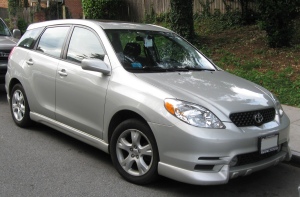
There are very few « Smart » lists that include pickup-trucks. Unless if you’re in the ranching or construction business, it’s pretty tough to justify a pickup truck. Maybe you’re a guy that wants to attract girls that like guys in pickup-trucks, and that’s cool. But if it’s to haul stuff from time to time, did you notice that most truck beds are shorter than eight feet? Our Toyota Matrix routinely hauls back some 8-foot long items back from Home Depot, with the seats down and the rear hatch closed. What about that bedroom set you might purchase on Craigslist? Well for that I have a hitch on one car and a 8×4 folding trailer in the garage, up against the side wall. It gets used once or twice a year to haul larger items, and take stuff to the dump. Put it this way, I’ve never been in a situation where I wished I had a pickup-truck and had to rent one, which of course is always an option.
Now let’s get to the really cool stuff. Getting your total cost of ownership even lower than the cars on Mr. Money Mustache’s list. For that you’ll need to choose the drive-train first and then the chassis, and be maybe prepare for an alternative fuel lifestyle. By-the-way the drive-train includes the engine and the transmission. It’s no fun to have a vehicle with a fantastic engine and be spending a lot of money on transmission repairs. When you focus on the drive-train first you’ll find many models that share the same components but only look different on the outside. A nice example is our Toyota Matrix, that shares the mechanicals of the Pontiac Vibe. Both use the venerable Toyota made 1ZZ-FE four cylinder also used on the Corolla.
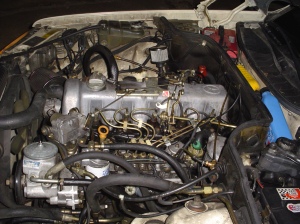
But the « pièce de résistance » is not the Toyota 1ZZ-FE, but a Mercedes OM-617 turbo-diesel. The OM-617 is a masterpiece of engineering from the 1970’s and 80’s that will put up with the harshest conditions and even neglect. According to Wikipedia “The OM617 is considered to be one of the most reliable engines ever produced with engines often reaching over 1.000.000 Km without being rebuilt and is one of the key reasons for Mercedes’ popularity in North America in the 1980s » But wait, there’s more … this engine will run on any oil, as long as the viscosity isn’t too high. Of course biodiesel, but you could also purchase a conversion kit to build a dual-tank system and run your car on used vegetable oil (VO). You read that correctly, you would only need regular diesel to start up on a cold day, and then drive using renewable fuel all day once warm. The OM-617 gets between 27-30 MPG combined, and when running on VO who’s counting? An experimental petroleum-diesel/VO hybrid trip to Las Cruces once when I wrote A Vegetable Oil Diesel Conversion Guide yielded the equivalent of 480 MPG on regular diesel. The MPG on VO was 27.5 MPG.
Running biodiesel or VO is sulphur-free, carbon neutral and certainly smells better. According to the EPA it’s also significantly less polluting. While it’s true that we use fossil fuels for farming, the plants temporarily capture carbon that ends up in the atmosphere wether or not we burn the oil. The only way to avoid the oil decay process that puts carbon back into the atmosphere is to keep oxygen away from the oils, and that’s not easily done. Just ask the dinosaurs about anaerobic decomposition. Filtering oil can be the hardest part of the process, and there are not many businesses that offer used but filtered vegetable oil for refilling professionally. You can check the U.S. DEO Alternative Fuels Database, or find a licensed business that pumps filtered and certified straight vegetable oil (SVO) fuel. The cost will typically be 2/3 of the price of diesel, and meet the strictest standards. Some folks end up doing this in their garages, but what if you don’t have a garage? Fortunately there’s guidance from Tonya Kay here for you Running Your Car on Waste Vegetable Oil, but check your local laws first.
Now going back to the drive-train choice, don’t overlook your long-term needs when selecting the body style to go along with your OM-617, or whatever your research turns up as the most awesome engine/transmission. When I did so I was commuting to Santa Fe and thought a long-wheelbase car would be best. But that job didn’t last for long and I found myself wishing I had purchased a wagon with that engine instead. The venerable W123 wagon is what I wish I had purchased instead of the W126.
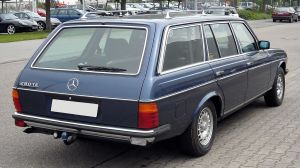
“Mercedes-Benz W123 T-Modell rear 20090430” by Rudolf Stricker – Own work. Licensed under Attribution via Wikimedia Commons.
I mentioned in the beginning of this article that I don’t like computers in my car, and I don’t think you will either in the long-run. Not only is it additional complexity and future maintenance cost, but there’s really a TCO disadvantage. Manufacturers used to place engine control systems in cooler places like the passenger compartment, or in a specially heat-protected enclosure. Today manufacturers are doing everything they can to reduce their materials costs, especially with copper wiring. I have seen the Engine Control Unit on 2014 models installed in the engine compartment, just inches above the exhaust manifold. Hmm, I wonder how long that unit will last?
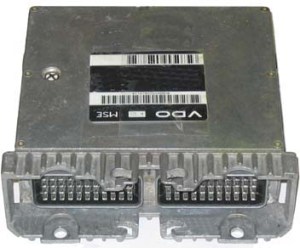
Today most people think that the technology is necessary, but it doesn’t seem to have been applied in the right places, at least when it comes to fuel economy. A fews years ago I purchased a 1997 Mercedes E300D with the intention of converting it to run on VO while writing a guide to cover the steps involved. It was a very beautiful diesel, much quieter than my 1981. But wait, its MPG was about 27, and it had a hybrid vacuum and electronic control system that I felt I would not be able to maintain easily as the car got older. I sold it for the same reason I sold the Prius. I want a vehicle I can maintain myself for the next 20-30 years. So if I purchase a 30-year old vehicle it had better have a 60-year life expectancy. How many vehicles can you think of fit in that category?
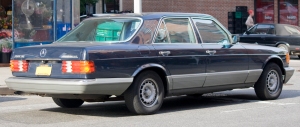
So we still drive the 1981 Mercedes 300SD known as a W126, and although it is much bigger car than I would liked it gets decent mileage. In fact it gets better diesel city mileage than the 2015 Mercedes E250BlueTEC Sedan, which is also rated at 27 mpg.
Strange, no? How little progress we’ve made with technology after 34 years of diesel engine development! Oh, and don’t tell me that other manufacturers are doing any better. I used to own a 1986 VW Golf that managed 45+ MPG, about what today’s 2015 VW Golf model is getting. The 300SD is an even bigger car than the E250, and mine gets 28 mpg around Albuquerque with a purely mechanical fuel injection pump and absolutely no engine electronics. I know that because I once drove back from Santa Fe with a dead alternator and a discharged battery. While a new car looks all shiny, why would anyone who cares about TCO purchase a new vehicle? Besides, if we get the Zombie Apocalypse I would place my bets with the 1980’s models.
With each passing year it seems that the 300SD purchase made in 1999 seems smarter. For one the resale value is basically unchanged, and has actually increased for some models. At the time my new purchase had 110,000 miles, and today with 280,000 miles it is still averaging much less than $500 in annual maintenance, and that includes fluids, pads, oil changes, every kind of repair over 16 years of ownership including an unexpected major engine overhaul (due to a previous mechanic’s mistake). For comparison Edmunds TCO Maintenance and Repair Costs for a 2009 Toyota Matrix is $1,968 per year, after 5 years of ownership. I’ve not found a single contemporary vehicle that I can keep running for less than $500/year.
Most owners ditch their cars after their first repair over $2000, but forget to average the cost over time. Even sticking with the higher maintenance costs of a more modern looking model from Mr. Mustache’s list, isn’t it better to make a car payment once in a while, rather than every month? But if you don’t care what people think about your old car, the biggest headaches you can expect with a 1970’s or 80’s Mercedes will likely have to do with window regulators, door checks and driver’s seat springs. I’ve since purchased another, a 1980 model. It also has the OM-617 engine with 120,000 miles. Brand new basically.
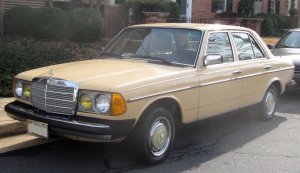
The bottom line is don’t necessarily look for a 1970’s or 80’s Mercedes wagon, but look for something with an amazing drivetrain and a hatchback body so you don’t need a pickup-truck. Look for a super reliable machine that you can keep for decades, and since you’ll be buying something at least a decade old to avoid too much expensive and fragile technology, you’ll be needing a car with a 50 year life-expectancy. Oh I almost forgot, people ask me where I get parts for the 80’s cars, as if that was a challenge. I buy original new parts online and sometimes the dealer if for some strange reason I can’t find it on online. Once in a while there’s something being parted out on Craigslist too, and that can yield some amazing savings. No matter your source, it’s important to avoid cheap after-market parts in something you want to serve you for several decades. I see my 34 year-old car as being middle aged, and hope it serves me for another 34 years. Well, unless if I find a W123 wagon with an OM617 turbo before you do. But you’d better hurry because I’ve noticed that prices have started rising quite dramatically, instead of falling as one might expect with a newer so called “modern car”.
If you have any cool ideas for reducing your own TCO, please leave them in the comments below.
Happy driving!
I love the W123s, especially in that creamy yellow– what a beaut!
Our 3 dogs, however, don’t fit in many cars, combine that with our love of finding extremely remote places, and I find myself looking for other ways to reduce my TCO, because I’m sticking with my Range Rover
The Range Rover is not a bad choice at all. I think you might be able to do a diesel conversion on it too. I know someone who put a Mercedes turbo-diesel engine in an FJ.
I’ll wait until it’s out of warranty first!